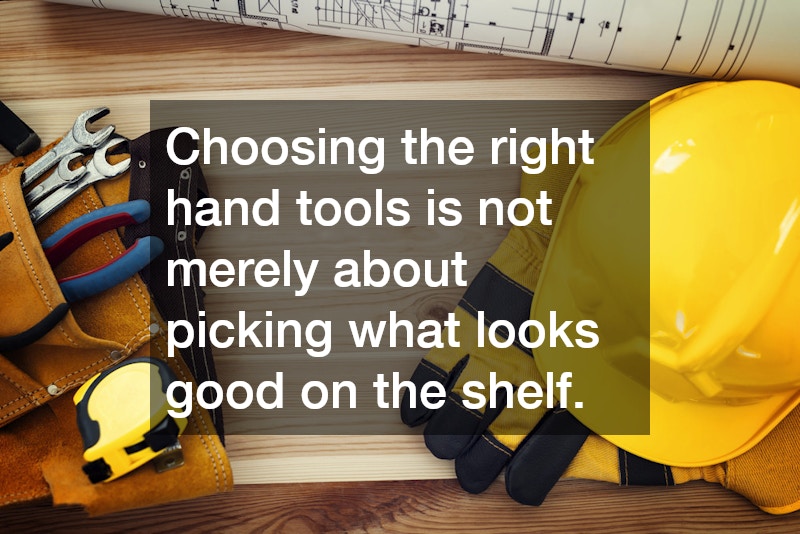Selecting the right hand tools can make or break the success of any DIY or professional project. Whether you’re an experienced tradie or a home renovator looking to upgrade your toolkit, understanding how to choose the most suitable tools for the job is essential. With the right guidance, you can save time, increase efficiency and achieve a more polished result—all while avoiding common pitfalls such as tool failure or personal injury.
This article will walk you through practical considerations when choosing hand tools, from assessing your project’s needs to understanding material quality, ergonomic design, safety standards and cost-effectiveness.
Understand the Scope of Your Project
Before heading to the hardware store or browsing online, take time to define the nature and scope of your project. Are you assembling furniture, repairing plumbing, constructing a deck or performing detailed woodworking? Each of these tasks may require a distinct set of tools.
For example, woodworking projects often require chisels, hand saws and mallets, whereas mechanical work demands spanners, screwdrivers and pliers. By clearly outlining your task requirements, you can avoid impulse purchases and ensure your investment goes towards tools you’ll actually use.
Invest in Quality Over Quantity
A common mistake among beginners is choosing toolsets with a high piece count for a low price. While these sets may seem economical, they often lack durability and precision. Cheap tools can wear quickly, cause damage to your project or even present safety hazards due to structural weaknesses.
Instead, focus on reputable brands known for quality and longevity. High-grade hand tools are typically made from materials such as chrome vanadium steel or carbon steel, which provide strength, corrosion resistance and extended usability. Tools with a solid warranty and positive reviews are usually a safer bet, especially if they’re to be used regularly or under tough conditions.
Prioritise Ergonomic and Comfortable Design
Comfort and ease of use should not be overlooked when choosing tools. Ergonomically designed tools reduce hand fatigue, enhance grip and improve overall safety during prolonged use. Look for features such as soft-grip handles, balanced weight distribution and non-slip textures.
This is particularly important for people with joint or grip issues, such as arthritis. Tools that fit well in the hand and require less effort to use can significantly reduce the risk of strain or injury over time.
Check for Safety Features and Compliance
Safety is a critical factor in tool selection. All tools sold in Australia should comply with relevant safety standards, such as those set by Standards Australia. Always check for safety certifications or marks, especially for items like cutting tools or electrical testers.
Additionally, look for design features that enhance safety, such as blade guards on utility knives, locking mechanisms on adjustable spanners or insulated handles on electrical tools. Never compromise on safety for the sake of saving a few dollars.
Match Tools to the Materials You’re Working With
Different materials require different tools. If you’re working with hardwoods, for instance, you’ll need sharper and more durable cutting tools than if you’re using soft timber. Similarly, projects involving metal or masonry call for hardened drill bits and specialised hammers or chisels.
Using the wrong tool for a particular material can damage both the tool and the project and increase the risk of injury. Always verify that your tools are designed for the intended material.
Consider Storage and Portability
If you’re building a mobile toolkit or working across multiple job sites, portability becomes a vital consideration. Lightweight and compact tools that come with a carry case or roll-up pouch can help you stay organised and efficient on the move.
For home workshops, consider storage solutions such as toolboxes, pegboards or wall-mounted cabinets. Keeping your hand tools well-organised not only prolongs their lifespan but also makes them easier to locate when you need them.
Balance Cost with Value
While it may be tempting to buy the cheapest tools available, it’s wise to weigh the initial cost against long-term value. A slightly more expensive tool that performs well and lasts longer often proves more economical over time than a cheaper alternative that breaks down or needs frequent replacement.
Watch for seasonal promotions or bundle deals from trusted retailers. Sometimes, you can acquire high-quality tools at a discount without compromising on performance or reliability.
Seek Expert Advice
If you’re unsure about which tools to purchase, don’t hesitate to ask professionals for guidance. Hardware store staff, trade experts or experienced DIYers can offer valuable insights into what works best for particular tasks. Online forums, how-to videos and user reviews are also excellent resources for learning from others’ experiences.
Being informed before making a purchase can save you considerable time, money and frustration.
Equip Yourself for Success with the Right Hand Tools
Choosing the right hand tools is not merely about picking what looks good on the shelf. It requires thoughtful evaluation of your project’s demands, an understanding of tool materials and ergonomics and a commitment to safety and quality. By taking the time to select wisely and maintain your tools properly, you’ll be well-equipped to tackle any task with confidence and precision.
.



